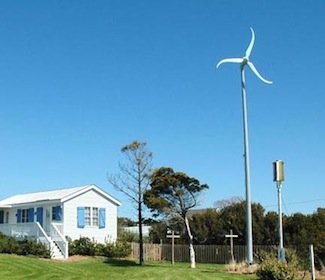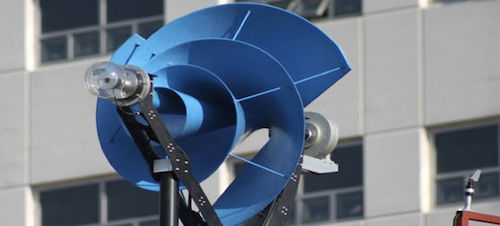Small Wind Turbines
Driving through a large commercial wind farm can be awe-inspiring, with hundreds of giant wind turbines turning majestically in the breeze, generating clean renewable energy for thousands of energy users. As a green homeowner, you may be inspired to want to create some or all of your home's energy on-site with a small wind turbine of your very own.
Small Wind Turbines for the Green Home
While most of the focus in the field of renewable wind energy goes towards larger commercial projects, the price of smaller wind turbine systems for residential use is falling quickly, and their efficiency is rising. More green homeowners are looking at small-scale wind energy as a source of renewable 'homegrown' energy, often in conjunction with residential solar power systems.Small wind turbine units usually have direct-drive generators, direct current output, with blades, bearings, and other components designed for simplicity and effectiveness, and built to last a very long time.
How Wind Energy Works
For a quick overview of wind power, see our article HERE.Small Wind Turbine Installation
Smaller residential wind turbines are typically mounted on a tower to raise them above ground obstacles and get them higher in the air where wind speed is usually higher. A general rule is that a turbine should be installed 30 feet higher than anything within 500 feet. Some small turbines are available which can be roof-mounted; these systems can suffer from turbulence, vibrations, and generate much less power than tower or pole-mounted turbines. Always make sure before purchasing any wind turbine equipment that your local ordinances allow for these taller towers.

Clean Green Power at Home
Types of Small Wind Turbines
Most smaller wind turbines are horizontal-axis turbines with the familiar 'windmill' appearance. They have the main rotor shaft and generator at the top of the tower, with a wind vane to point the blades into the wind.
Newer vertical-design turbines are becoming available for use in areas with more variable wind speeds or for roof-mounted systems. Vertical-axis designs have the main rotor shaft placed vertically, which means the turbine doesn't have to be pointed into the wind in order to work. Another advantage is that the generator and gearbox can be placed closer to the ground, making maintenance much easier.
Energy Production and Cost of Small Wind Turbine Systems
The average U.S. home uses between 6,500 and 10,000 kilowatt hours per year. A small wind turbine system can offset some or all of a home's utility power with renewable wind energy. In 2007, the average cost per kilowatt hour of power created by a home wind energy system was about 105 cents per kilowatt hour.
Residential wind turbine systems typically have an output of around 2 to 10 kWh and cost anywhere from $10,000 up to $50,000 and beyond. Local, state, and federal tax credits and rebate programs can often reduce the up-front cost of a wind system by up to 50% (Read more HERE) The amount of time it takes to recoup the purchase and installation costs of a small wind turbine in energy savings is estimated to be between 5 and 10 years, depending on the turbine size, the amount of locally-available wind, and the local rate for electricity from the utility company.
*It's important to note that replacing utility power completely with renewable power (going 'off-grid') requires batteries to store power; this can add thousands of dollars to a residential energy system.
Almost all of wind energy's costs are up-front. The free wind energy will eventually cover the large up-front costs, but it can take a long time. How much you save depends on the energy efficiency of your home and your local electricity rates. However, depending on your wind turbine system size, wind quality, permit and energy costs, and turbine performance, payback periods for small wind systems range from 5 to 10 years.
Silent Wind Power : The Archimedes Liam F1 Small Wind Turbine
Archimedes, a Dutch company, has introduced the Liam F1 small wind turbine, designed for residential or commercial usage. This unique, conical-shaped turbine is designed to be much more efficient at converting wind to electricity than traditional turbines. Even better for homeowners, the new Liam F1 is extremely quiet...nearly silent. The Liam F1 rectifies two major complaints with small wind turbines: low efficiency and loud noise. Read more about the Archimedes Liam F1 small wind turbine HERE.
A wind turbine spinning proudly over your home is a powerful symbol of your commitment to renewable energy.
comments powered by Disqus




























































































































































































